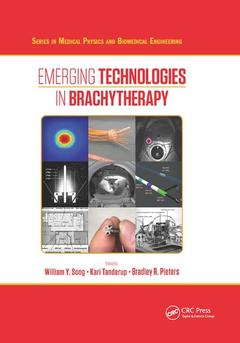Emerging Technologies in Brachytherapy Series in Medical Physics and Biomedical Engineering Series
Coordonnateurs : Song William Y., Tanderup Kari, Pieters Bradley

Brachytherapy is continuously advancing. Years of accumulated experience have led to clinical evidence of its benefit in numerous clinical sites such as gynecological, prostate, breast, rectum, ocular, and many other cancers. Brachytherapy continues to expand in its scope of practice and complexity, driven by strong academic and commercial research, by advances in competing modalities, and due to the diversity in the political and economic landscape. It is a true challenge for practicing professionals and students to readily grasp the overarching trends of the field, especially of those technologies and innovative practices that are not yet established but are certainly on the rise.
Addressing this challenge, Emerging Technologies in Brachytherapy presents a comprehensive collection of chapters on the latest trending/emerging technologies and expert opinions. It is divided into five broad sections:
- Section I: Physics of Brachytherapy
- Section II: Imaging for Brachytherapy Guidance
- Section III: Brachytherapy Suites
- Section IV: Is Brachytherapy a Competitive Modality?
- Section V: Vision 20/20: Industry Perspective
Each section has a carefully selected collection of chapters, which covers the spectrum of topics in comprehensive detail. By drawing on recognized experts and key opinion leaders from academia and commercial sectors worldwide (100+ contributors), Emerging Technologies in Brachytherapy provides readers with a wealth of relevant information needed to comprehend the rapidly advancing technologies and trends of today and the prospects for the future.
Introduction
Sources and Loading Technologies
Applicators
Applicator Reconstruction
Dose Calculation
Dose Optimization
Image Processing for Brachytherapy
FMEA for Brachytherapy
Real-Time In Vivo Dosimetry
Quality Assurance Technologies
Additive Manufacturing (3D Printing) in Brachytherapy
Robotics in Brachytherapy
Optical Imaging and Navigation Technologies
Ultrasound
X-Ray and Computed Tomography
Magnetic Resonance Imaging
Positron Emission Tomography
Imaging for Treatment Verification
Medical University of Vienna, Vienna, Austria
University Medical Center Utrecht, Utrecht, The Netherlands
Emerging Technologies in Brachytherapy
Hospital Charles Lemoyne, Montreal, Canada
Sunnybrook Health Sciences Centre, Toronto, Canada
Princess Margaret Cancer Centre, Toronto, Canada
Tata Memorial Hospital, Mumbai, India
Institut Joliot-Curie Cancer Center, Dakar, Senegal: Implementing a Brachytherapy Program in a Resource Limited Setting
EBRT or Brachytherapy?
Particle Therapy or Brachytherapy?
Is Brachytherapy Cost Effective?
Elekta Brachytherapy
Eckert & Ziegler BEBIG
Dr. William Y. Song is the Head of the Department of Medical Physics at the Odette Cancer Centre, Sunnybrook Health Sciences Centre, in Toronto, Canada. This is one of the largest medical physics units in the world with 50+ staff. Along with a busy external beam radiotherapy program, the centre sees close to 600 brachytherapy patients a year, making it the busiest program in Canada. Since joining the centre in 2014, he has been an Associate Professor in the Department of Radiation Oncology, Adjunct Professor in the Institute of Medical Sciences, Institute of Biomaterials and Biomedical Engineering, and Department of Mechanical and Industrial Engineering, at the University of Toronto. He is also an Adjunct Professor in the Department of Physics, at the Ryerson University, Toronto, Canada. He received his PhD degree in 2006 at the University of Western Ontario, London, Canada, on the topic of image guided treatment approaches for prostate cancer. Since then, he has pursued research in the field of image guidance systems, 4D motion management technologies, and brachytherapy, resulting in over 50+ peer-reviewed publications and 130+ conference abstracts. Along the way, he became a fully certified medical physicist (American Board of Radiology, 2010), directly supervised(ing) 20+ MSc and PhD graduate students, an ad hoc reviewer for 20+ research journals, and is a member of the Board of Associate Editors for the Journal of Medical Physics. In brachytherapy particular, his research focus has been in developing novel applicators and MR image processing techniques that enhances plan quality and plan quality evaluations; one in particular, in cleverly designing MR-compatible metal alloys to create non-isotropic dose distributions that can, in combination with inverse planning, gain exceptional dosimetric conformality for use in image guided adaptive brachytherapy.
Dr. Kari Tanderup is Professor at Department of Oncology, Aarhus University Hospital in
Date de parution : 12-2019
17.8x25.4 cm
Date de parution : 05-2017
17.8x25.4 cm
Thèmes d’Emerging Technologies in Brachytherapy :
Mots-clés :
Proton Beam Therapy; Prostate Brachytherapy; Cervical Cancer; Prostate HDR Brachytherapy; HDR Brachytherapy; Interstitial Brachytherapy; Deformable Image Registration; Treatment Verification; Dose Distribution; AAPM TG-192; DVH; Brachytherapy Suite; TRUS Image; MBDCA; Intracavitary Brachytherapy; Interstitial Needles; HDR Source; Cone Beam CT; Intracavitary Applicators; PDR; Brachytherapy Treatment; Particle Therapy; Dwell Position; CTV Hr; Vivo Dosimetry



